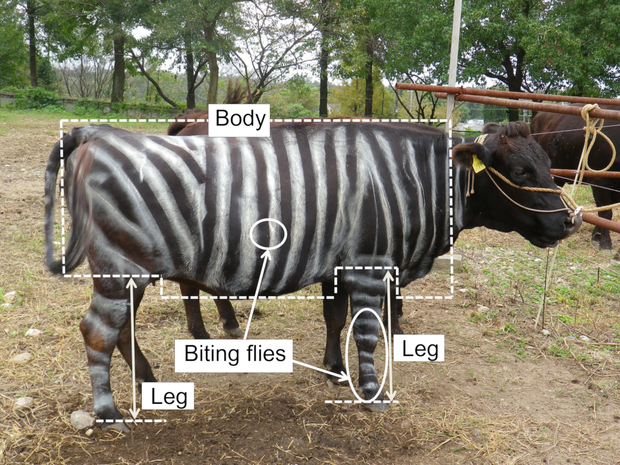Why painting zebra stripes on cows could save the agriculture industry major money
Tokyo — An experiment on a herd of cows in central Japan appears to have proven a radical, nature-inspired solution to a pest problem that plagues the agriculture industry.
Zebras and their gaudy coats have long intrigued scientists, spawning a raft of theories about how and why a few equine species developed stripes. The consensus finally settled around a single answer: The zigzag pattern was an evolutionary response to biting insects, especially carriers of deadly diseases. Insects, it seems, have a harder time landing on striped surfaces than solid-colored ones.
If it works for wild horses in Africa, why not cows in a Japanese pasture? So pondered the staff of the Aichi Agricultural Research Center, outside the city of Nagoya. Together with ag school colleagues at Kyoto University, the center decided to run an experiment on its herd of Japanese black cattle.
Using water-based spray paint, one group of cows was given a fresh coat of white stripes, about two inches wide, each morning. A second group got black stripes, and a third, the control group, went paint-free.
Researchers then sat back and watched as the flies descended, photographing the animals for 30-minute intervals and capturing sample insects with glue traps. Staff observed how frequently the cows did what cows do to ward off airborne blood-sucking pests; shook their heads, flicked their tails and skin-twitched.
The white-striped animals, looking for all the world like a bovine chain gang, were no small source of barnyard mirth.
"People thought it was some kind of joke," one staffer told Japan's NHK state TV network. But the results of going zebra were undeniable.
The white-striped cows sustained only half as many bug attacks as either of the other groups. (Paint fumes apparently were not enough to deter flies, since black-striped cows were bitten just as often as the control group.) Animals protected by their white stripes were also less stressed, exhibiting fewer head shakes, foot stomping, and other insect-avoidant behavior.
In a report published in the online journal PLOS One, the Japanese scientists said the results suggest a promising, pesticide-free alternative to protecting livestock from biting flies - a menace which, according to one U.S. study, costs the beef and dairy industry more than $2 billion annually.
Serious economic implications aside, online reaction in Japan was emphatically positive. "What about a spider web pattern? That would really throw off the bugs," wrote one. "When are we getting zebra clothes for humans?" another commented.





